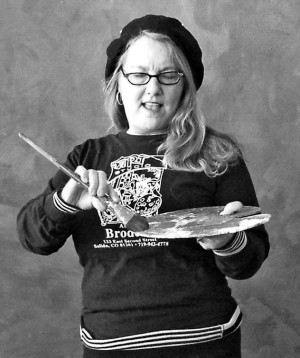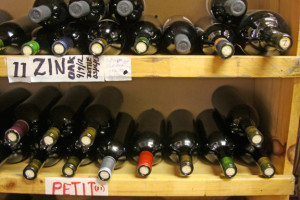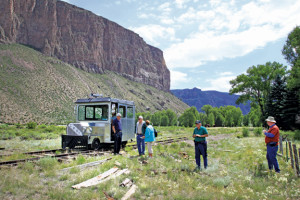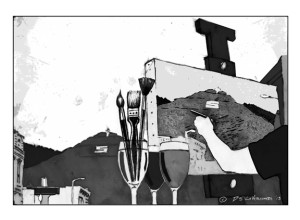By Jane Koerner
The lonesome straightaway on Highway 24 lured me into complacency. For miles I had been defending my lightweight Honda Civic against the crush of bumper-to-bumper traffic and the shock of worn pavement. There is no vision like tunnel vision. I looked away from the gun sight of my windshield for some psychic relief, toward the white halo of clouds adorning Pikes Peak. Dead ahead at the next curve, a long line of red brake lights was blinking. I was oblivious, so it’s a good thing I’ve got the quickest foot in the Rocky Mountain West. In the bloody aftermath of a chain-reaction accident, I’d be outgunned and defenseless when the mob of disgruntled drivers hunted me down.
“If you were born in 1950,” Paul Hawken said in a speech at the university where I used to work, “you are a member of the first generation to see the population of the world triple in your lifetime.” I was born in 1950, and I didn’t contribute a single baby. So don’t blame me. Unless you count the Humane Society mutt who followed me everywhere in the Colorado Rockies for the better part of ten years – across swollen creeks at the height of June runoff, through cliffed-out couloir and bog-laced willow patch. Or the albino cat I accidentally killed in the dryer after she crawled in with the soiled white sheets and fell asleep while I was talking on the phone.
Most of the time I would rather walk. I have to be careful, though. I might get run over by my neighbor’s Humvee or attacked by that pack of pompadoured poodles patrolling my street.
It used to be relatively straightforward to get around in the mountains. In 1916, Elinor Davis Ehrman caught the train from Colorado Springs to Cripple Creek and walked from there to the Sangre de Cristos. In Crestone, at the western foot of the range, she and her party met up with Albert Ellingwood for the first ascent of Crestone Peak. On the 150-mile approach to the rendezvous in Crestone, ranchers supplemented Elinor’s meager food supply with canned goods and offered cottonwood trees as an overnight spot to sling up the tarp.
People were friendly to strangers in those days.
“You’re lying on my property,” he said.
It was my second summer of mountaineering, and my right knee had locked up into premature rigor mortis as I peeled off Mount Oxford in the Sawatch Range and descended into the first steep boulder field. I didn’t carry ski poles in those days, and to spare my dying knee, I sat down and crab-walked on my hands and feet through the unsteady rock. The turf provided no relief. It was mined with hidden gopher holes and downed trees. Near the bottom of the last pitch, just before it plunged into the trail, I came upon an occupied campsite. The hospitable couple consoled me with a Sierra cup of wine and found a branch that enabled me to crutch myself down the last 500 feet to Chalk Creek and the road. The first log cabin I saw looked like it was part of a ghost town. I didn’t notice the curtain flapping in the breeze of a broken window until the owner stood over me, shaking his fist.
“I’m sick,” I explained.
“You’re trespassing, and I’m gonna call the Chaffee County sheriff.”
I stuffed my empty bottles of Ibuprofen and sunscreen into my pack and crawled off in the direction of the trailhead parking lot.
I knew the man wasn’t a native. The natives don’t wear North Face down vests, and they pronounce the county capital Buena Vista, byoona veesta.
Later, as I contemplated the fate of our Ute predecessors, I thought of the perfect retort: “We’re all trespassers.”
The hostile reception in Vicksburg stuck with me for weeks, and Uncle Fred came to mind. No one messed with him. An antique gun dealer, he had enough muskets and Winchesters and Colt 45s in his farmhouse to defend himself against an entire militia. A pack of stray Labradors guarded the concrete bunker where he stored his ammunition.
Burt’s approach made more sense. He was a third-generation Colorado native and Colorado College history major like me.
“They’re fencing me in,” said Burt, tugging his cowboy hat down over his weathered forehead the day I visited him at his modest cattle ranch between Gunnison and Crested Butte. He was showing me the Lindal cedar home that was going up fast in the pasture on his west property line. His 100-year-old barn could fit inside the house, with plenty of room left over for the rustic log cabin that sufficed for a home.
A few weeks before my visit, a BMW had pulled into his barnyard. The driver introduced himself as an attorney from Los Angeles. Glancing at the rusting, dented pickup parked outside Burt’s cabin, and the bleached sofa with the perforated cushions on the front porch, he said, “Looks like you could use some cash.”
“I’m not selling,” said Burt, anticipating the next move.
“What will it take?”
Burt stared at his chic cowboy hat and said nothing.
“What will it take?” The lawyer reached into his jacket pocket and pulled out his checkbook.
“One hundred thousand an acre. Cash.”
“Sagebrush around here sells for $10,000 an acre!”
“That’s my price.”
Burt kept a poker face as he recounted the story. It was getting late, and we decided to watch the sunset together. To the west, the stainless steel roof of the near-finished trophy home turned scarlet as the sun dropped behind the West Elks. The chill penetrated my joints. Burt looked content. Just wait until December, he said, when the first storm of the season roars in from the mountains, and the winds galloping along in its wake whip five feet of snow across the road, and they realize that even with chains their four-wheel drive is stuck.
He had a point. In years past, before the impact of climate change became painfully obvious, it wasn’t that unusual for a rancher to be taken by surprise by an Arctic Front that swung down from the Pacific Northwest, freezing his cattle in their snowy tracks before he could pull his boots on and hustle his life’s work to shelter.
The rear brake lights stop blinking, and I hit my brakes in the nick of time. In the distance, I see the golden arch of McDonald’s hovering above a parking lot like a rainbow. If I drive through the arch and keep going, I can steam clean my Honda Civic at the nearby car wash. At age 62 I take the Girl Scout motto seriously. In the age of the almighty automobile, St. Peter will run his calloused hands along the satin finish of your automobile and gaze into his reflection before letting you in. The pedestrians will be turned back by the no trespassing sign at the pearly gates.
Jane Koerner recently moved to Fairplay, Colorado, the perfect altitude for writing her memoir based on her mountaineering experiences as the first woman to climb the 100 highest peaks of Colorado.




